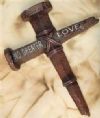|
ESL Forum:
Techniques and methods
in Language Teaching
Games, activities
and teaching ideas
Grammar and
Linguistics
Teaching material
Concerning
worksheets
Concerning
powerpoints
Concerning online
exercises
Make suggestions,
report errors
Ask for help
Message board
|
ESL forum >
Ask for help > worn-in vs worn-out (trousers/ t-shirt etc.)
worn-in vs worn-out (trousers/ t-shirt etc.)
|

jarek2011

|
worn-in vs worn-out (trousers/ t-shirt etc.)
|
|
Hi,
I have stumbled across a phrase "worn-in t-shirt" in a book and I am racking my brains over the meaning of the phrase. I tried to puzzle it out from the context and I think I know what it means but I want to be sure. Is it sth like a fake old t-shirt that is brand new and you buy in a shop but the t-shirt looks worn-out? |
8 Oct 2012
|
|
|
|

MarionG

|
|
I can �t say i �ve heard iy in English before but in Dutch it would mean that a something has been worn to such a degree that it is now comfortable and has a cool look (since often clothing/shoes/bags, etc. look kinda stiff whan they are bandnew. ) Worn-in is very personalized, it fits the wearer �s body. It wouldn �t be used for new items that are made to look worn (since every body is different). In English I �ve heard the expression �worn-look � for new items that are made to look used, and of course �worn-out � for something that has been worn too often, �worn-in � is new for me but I �m not an expert on style terminology (my style basically being limited to jeans and t-shirt) |
8 Oct 2012
|
|
|

Terri Lawson

|
|
Hi Jarek, I agree with Marion - isn �t English a funny old language! :-))
|
8 Oct 2012
|
|
|

5puravida5

|
|
I �m a native speaker and I think there is some confusion here. Worn out can refer to an article of clothing that is old and well used and ready to be thrown out. But worn in and worn out are opposites with a different connotation. A worn in shirt would be one that is tucked into your pants or shirt...in other words the shirt would be put under the pants or skirt at the waist or worn in. Worn out you would wear the shirt outside of or over the pants or skirt. Certain shirts are meant to be worn out(side) because of the cut or finish but for instance, men �s shirts, are tailored to be fitted inside the pants or worn-in. I have NEVER heard it used in the context you suggested of being old or new. Worn-in is not the opposite of worn out in that context. Hope this helps. |
8 Oct 2012
|
|
|

yanogator

|
|
Marion �s description would be fore "broken in", which can be used for clothes, but isn �t really common.
I agree with Spuravida5 �s explanation.
Bruce |
8 Oct 2012
|
|
|

foose1

|
|
I have to agree with Marion G. Levis started to make worn in levis after the sixties because it looked good and people wanted the worn in look. Stone washed was a key to worn in levis. I know this to be true because I always looked and purchased new levis that had the worn in look and feel because they were comfortable. The earlier levis took a lot of washings before thy had the worn in look and feel. Worn out are clothes or accesories that are worn out but maybe still useable. John |
9 Oct 2012
|
|
|

douglas

|
|
I have used the term "worn in" or "to wear in" when talking about shoes. For example:
"These new shoes are a little tight now, but they will be fine once I �ve worn them in some."
Meaning the shoes need to be worn a little before they fit properly/are comfortable to wear.
"Worn out" means they are ready to be thrown away. |
9 Oct 2012
|
|
|

zoemorosini

|
|
I agree with Yanoganator. In the U.S., it �s more common to say "broken in" for circumstances in which a person has bought something new and needs to wear it for a certain time to make it comfortable and individualized. For example, when I buy a new pair of leather boots, it takes a few months for me to break them in. After that, they are my "go-to" footwear; in other words, they �re my favorites. I don�t use "broken in" or "worn in" for clothes. |
9 Oct 2012
|
|
|













